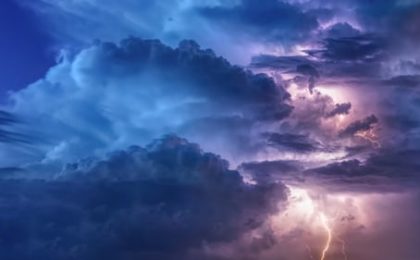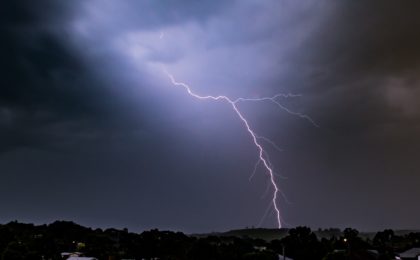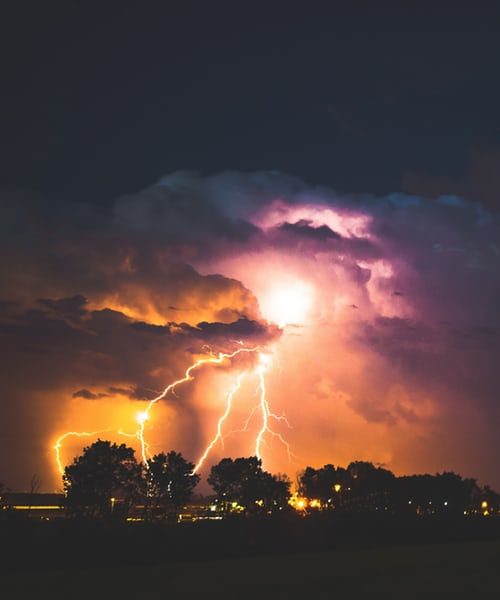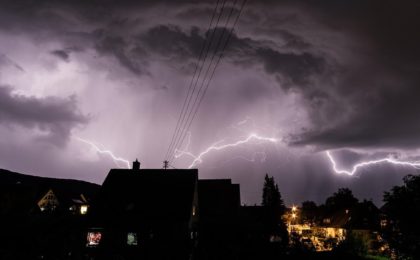How To Be Prepared for Lightning
No one wants to deal with a lightning bolt slamming into their house. But being on this planet means that lightning will hit somewhere at any given time.
And sometimes that somewhere IS your house.
But what do you do? What should you expect? And how can you deal with the aftermath?
Lightning strikes DO happen. 2023 saw over 70,000 claims, and that was a 13.8% increase from 2022. There is an entire Lightning Safety Institute that deals with the damage this risk causes to both people and their property.
Let’s walk through exactly how you can handle a lightning strike hitting your home, and find out how you can stay safe.
And deal with the claim after.
GET YOUR FREE PERSONAL INSURANCE CHECKLIST!

What to Do in a Storm

If there is a serious lightning storm over your house, start by taking precautions.
- A general rule is the 30-30. If you hear thunder 30 seconds after seeing lightning, go inside and know that lightning could strike your area.
- Unplug electrical devices in case of a surge. Do not touch any electrical device that is still plugged in – even a landline phone.
- Avoid any faucet or fixture that has running water. Electricity can travel through pipes.
- Do not stand on concrete floors or touch concrete walls. Electricity can travel through metal wiring inside of them.
These simple steps can help keep you and your loved ones safe if you do encounter a lightning strike.
But what happens if lightning DOES hit? What do you do then?
What to Do if Lightning Strikes

If lightning does hit your house, chances are a few things may happen. Let’s look over what you need to look for in the aftermath.
- Make sure no one is hurt! If someone has suffered any harm, seek medical assistance immediately. When in doubt dial 911.
- Look for signs of a fire – Smoke, charred electrical outlets or heat from your attic, etc. If there is a fire follow our What To Do If You Have A Fire guide.
- Make sure there isn’t damage that could create a dangerous situation. A whole in the roof, hanging beams, exposed wires, all of these can cause injury.
- Check for other damage – Shorted appliances, fried wiring, blasted roof shingles, damaged trees, or downed powerlines.
The primary thing is to BE SAFE. You don’t want to survive the actual strike itself and then put yourself in a position of being hurt after.
Lightning can cause as many dangerous situations as it presents itself. Fire is the most common risk from a lightning hit, and it can start in hard-to-find places that hide detection.
Make sure you check attics, look at electrical outlets for burn marks, and (once it is safe and the storm has passed) look at your roof to make sure there isn’t smoke or other signs of a fire in your home.
Dealing With Damage

If you do have damage, you need to know how to deal with it while staying safe.
But you also need to know how to make sure the damage doesn’t spread, or lead to other issues that can harm your home even more.
Here are some examples of damage and how to reduce the chances of further problems.
- Hole in the roof – The obvious potential issue with this is water damage. Rain can seep into the home and damage wood, drywall, electrical systems, and just about any other part it can find. If at all possible, cover the hole with a tarp or other temporary solution unit repairs can be made.
- Shorted electrical systems – If you find that appliances or even entire rooms are not working, it’s possible that lightning caused a short or another issue with the appliance. If it is an entire room, there could be a much more serious electrical problem. Make sure you cut the electricity to any areas that are having issues until a pro can look at it. But be careful when dealing with fuse boxes or anything else electrical after a lightning strike. When in doubt, let an electrician handle it.
- Signs of fire – If you see char marks or burns on walls, near electrical outlets, or the aftermath of actual flames, make sure there isn’t any actual fire somewhere in the house. If you suspect anything or see smoke, call the fire department. Once you know there isn’t any fire, check for fire damage in walls, in attics, or wherever the marks may lead.
The main takeaway is to do what you can to prevent further damage and make the area safer.
BUT! Make sure you don’t put yourself in harm’s way while trying to do so! If something looks dangerous or even just out of your comfort zone, wait for a professional to help.
Surviving a lightning strike and getting electrocuted while trying to turn off your power is not worth whatever you were trying to prevent.
Last but not even close to being least: TAKE PICTURES. Document everything that may be important so you can show the right people in the next section what happened.
Filing A Claim

The sad truth of the matter is that if your home has been hit by lightning, you’ll need to file a claim.
The good news is that this is exactly the reason why you have insurance, and your agent, company and adjuster will work together to help get you back to where you were before this happened.
Filing a claim is easy, and you can do it as soon as you realize you are safe. Or you can wait until the next day when you’re in a better state of mind.
- Report the claim to your insurance carrier. While your agent would like to know that you are safe, the first order of business is to let your insurance company know that there has been lightning damage. They are the ones with the claims department and will be in charge of getting you the funds you need to repair or rebuild.
- Tell your agent. You can call, email, text, use the app – whatever method you prefer to let them know. Some agents even have an online form for reporting claims. This would be a good time to discuss the damage that you’ve had, any dangers that might still be present, and what advice they have for keeping you safe.
- Communicate with your adjuster. Once your adjuster has called you back, make sure to get them the information that they need so you can get the claim handled correctly. Give them all of the pictures you took of the damage so they can see what happened and maybe note any items that were damaged that you forgot about.
Once you’ve taken these steps, you will be well on your way to getting your homemade whole again.
Make Sure You’re Protected

No one wants to have to go through lightning hitting their house. And if you do, you want to make sure you have the right insurance.
The good news is that you don’t have to do this alone. We have created a FREE INSURANCE CHECKLIST that guides you through the questions you need to ask to make sure you’re covered, step by step. If you aren’t getting a regular review, this checklist is a must. And even if you are getting a review, this can help you know what to look for so you’re informed, confident, and ready to rock your insurance like a boss.
Sound great? Click on the link below and get your FREE INSURANCE CHECKLIST today.
